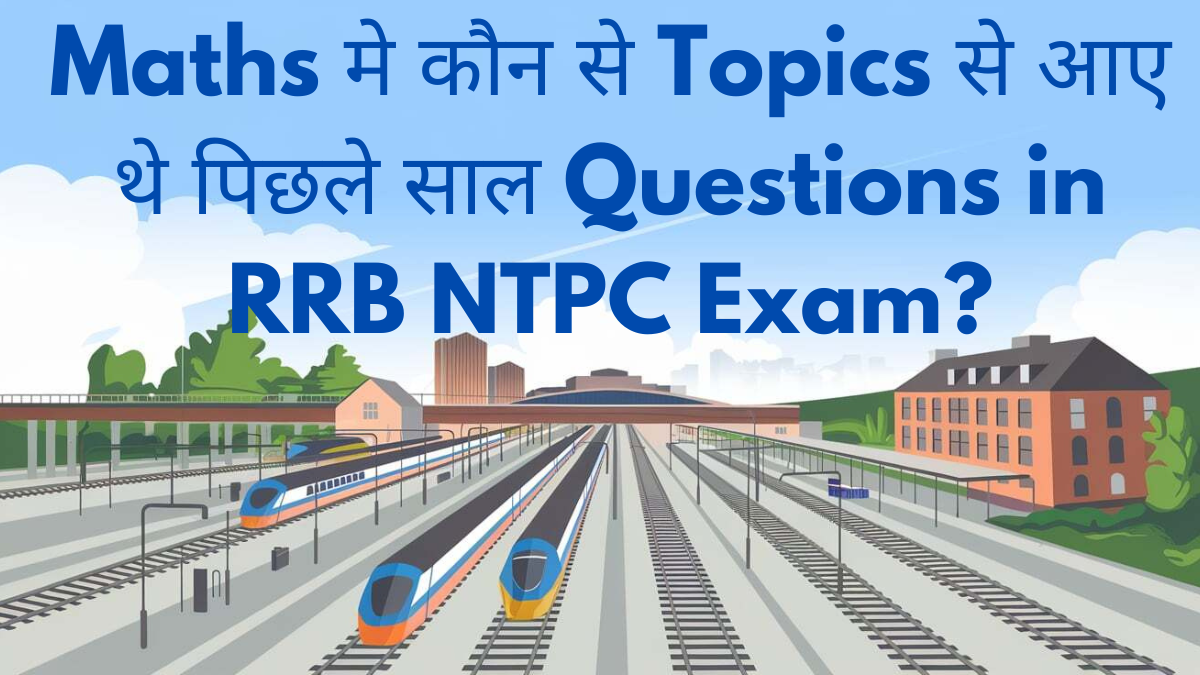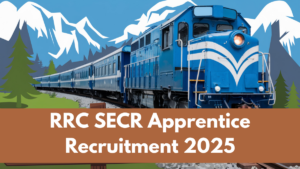Table of Contents
The Railway Recruitment Board has released the 11,558 vacancies for Non Technical Popular Categories. Candidates preparing for this exam should familiarize themselves with the topics covered in last year’s RRB NTPC exam. Among the three sections of the exam, Arithmetic is particularly important as it offers significant potential for improving overall scores. This article will explore the various arithmetic topics that appeared in the previous year’s RRB NTPC exam.
Maths Topics Asked in RRB NTPC Previous Year Exams
The Mathematics section in the RRB NTPC exam consists of 30 questions in the preliminary round and 35 questions in the mains examination. These questions cover various topics tabulated below. In last year’s exam, the difficulty level of the questions ranged from easy to moderate on average. By analyzing this distribution, candidates can develop more effective preparation strategies, focusing their efforts on areas that typically carry more weight in the exam.
| Topic | Marks |
|---|---|
| Number System | 2 |
| Decimals | 1 |
| Fractions | 2 |
| LCM and HCF | 2 |
| Ratio and Proportions | 3 |
| Percentage | 3 |
| Mensuration | 2 |
| Time and Work | 3 |
| Time and Distance | 2 |
| Simple and Compound Interest | 1 |
| Profit and Loss | 3 |
| Elementary Algebra | 3 |
| Geometry and Trigonometry | 3 |
| Elementary Statistics | 1 |
| Total | 30 |
Maths Questions Asked in Previous Year RRB NTPC Exams
These topics frequently appear in the RRB NTPC exam. You may encounter multiple questions from a single topic in one shift, making it crucial to practice these areas. Mastery of these subjects can significantly improve your scores in the exam.
Time and Work
This section deals with problems involving the time taken to complete tasks, either individually or collaboratively. Questions often require calculating work efficiency and time savings when multiple workers are involved.
Q. Working alone, A can do a job in 15 days and B can do the same job in 18 days. In how many days will the job be completed if both work together?
(a) 10/3 days
(b) 90/11 days
(c) 5/36 days
(d) 15 days
Q. P is twice as efficient as Q. Q takes 12 days to complete a job. If both of them work together, how much time will they take to complete the job?
(a) 6 days
(b) 5 days
(c) 4 days
(d) 3 days
LCM and HCF
Least Common Multiple (LCM) and Highest Common Factor (HCF) problems test understanding of number relationships. These questions often involve finding LCM/HCF of fractions.
Q. The LCM of two numbers is 210. If their HCF is 35 and one of the numbers is 105, find the other number.
(a) 35
(b) 70
(c) 105
(d) 140
Q. Find the LCM of 25/7, 15/28, 20/21.
(a) 300/7
(b) 300
(c) 320/23
(d) 320
Profit and Loss
This topic covers calculations related to business transactions, including profit percentages, selling prices, and cost prices. Questions may involve multiple transactions or comparing different pricing scenarios.
Q. 3 chairs and 2 tables cost Rs. 700 and 5 chairs and 3 tables cost Rs. 1100. What is the cost of 1 chair and 2 tables?
(a) 350
(b) 400
(c) 500
(d) 550
Q. A sold a toy to B at a profit of 15%. Later on, B sold it back to A at a profit of 20%, thereby gaining Rs. 552. How much did A pay for the toy originally?
(a) Rs. 2400
(b) Rs. 2560
(c) Rs. 2760
(d) Rs. 2800
Q. P bought an article for Rs. 400 and sold it at a profit of 10%.What would have been the increase in the profit percent if it was sold for Rs. 460?
(a) 5%
(b) 10%
(c) 12%
(d) 15%
Number System
Number system questions test basic arithmetic skills and understanding of number properties. This includes working with prime numbers, squares, cubes, and applying divisibility rules.
Q. A positive number exceed its positive square root by 30. Find the number.
(a) 16
(b) 36
(c) 25
(d) 49
Q. The sum of digits of a two-digit number is 10. When the digits are reversed, the number decreases by 54. Find the changed number.
(a) 73
(b) 28
(c) 82
(d) 37
Time and Distance
These problems involve calculations related to speed, time, and distance. Questions often require finding average speeds or determining travel times under various conditions.
Q. A car travels at the speed of 50 km/hr for the first half of the journey and at the speed of 60 km/hr for the second half of the journey. What is the average speed of the car for the entire journey?
(a) 54.54 km/hr
(b) 36.36 km/hr
(c) 50.5 km/hr
(d) 45.45 km/hr
Q. A train crosses a stationary object in 10 seconds. What is the length of the train if the speed of the train is 25 m/s?
(a) 300 m
(b) 250 m
(c) 320 m
(d) 200 m
Ratio and Proportions
This section tests the ability to understand and manipulate ratios in various contexts. Problems often involve dividing quantities in given ratios or finding missing values in proportions.
Q. The incomes of A and B are in the ratio of 3:2 and their expenditures are Rs. 14,000 and Rs. 10,000 respectively. If A saves Rs. 4000, then B’s savings will be:
(a) Rs. 4000
(b) Rs. 2000
(c) Rs. 3000
(d) Rs. 5000
Q. If three numbers are in the ratio of 1:3:5 and their sum is 10,800. Find the largest of the three
numbers.
(a) 1200
(b) 3600
(c) 6000
(d) 5400
Elementary Statistics
Statistics questions focus on measures of central tendency like mean, median, and mode. Candidates need to calculate these values for given data sets or interpret statistical information.
Q. What is the median of the following list of numbers: 5, 3, 6, 9, 11, 19, and 1 ?
(a) 5
(b) 6
(c) 9
(d) 11
Q. What is the mode of the following list of numbers:
2, 4, 5, 6, 5, 4, 3, 5, 3, 1, and 7?
(a) 3
(b) 4
(c) 5
(d) 2
Mensuration
Mensuration problems involve calculating areas and volumes of various geometric shapes. Questions may require converting between different shapes while maintaining certain properties.
Q. A wire when bent in the form of a square encloses an area of 484 sq. cm. If the same wire is bent in the form of a circle, what is the area enclosed by it?
(a) 264 sq. cm
(b) 616 sq. cm
(c) 488 sq. cm
(d) 492 sq. cm
Simple and Compound Interest
These questions test understanding of interest calculations over time. Problems may involve finding principal amounts, interest rates, or time periods for both simple and compound interest scenarios.
Q. What will Rs. 40,000 amount to in 2 years at the rate of 20% p.a., if interest is compounded yearly?
(a) Rs. 48,620
(b) Rs. 58,564
(c) Rs. 57,600
(d) Rs. 60,000
Q. How long will a sum of money take to double, if it is invested at 9.09% p.a. simple interest?
(a) 12 years
(b) 14 years
(c) 11 years
(d) 13 years
Trigonometry
Trigonometry questions typically involve practical applications of basic trigonometric concepts. Problems often relate to finding heights or distances using trigonometric ratios in right-angled triangles.
Q. Two poles of the height 12 m and 17 m stand vertically upright on a plane ground. If the distance between their feet is 12 m, find the distance between their tops.
(a) 11 m
(b) 12 m
(c) 13 m
(d) 14 m
Q. X is 5 ft tall and he notices that he casts a shadow that’s 3 ft long. He then measures that the shadow cast by his school building is 30 ft long. How tall is the building?
(a) 50 ft
(b) 18 ft
(c) 90 ft
(d) 150 ft
Average
Average problems test the ability to calculate and manipulate arithmetic means. Questions may involve finding overall averages from multiple sets or determining missing values to achieve a given average.
Q. The average of 11 results is 50. The average of the first 6 results is 49 and that of the last 6 results is 52. What is the 6th result?
(a) 48
(b) 51
(c) 56
(d) 49



 RRB ALP Salary 2025, Check Job Profile a...
RRB ALP Salary 2025, Check Job Profile a...
 RRB ALP CBT 2 City Intimation slip 2025 ...
RRB ALP CBT 2 City Intimation slip 2025 ...
 RRC SECR Apprentice Recruitment 2025 Out...
RRC SECR Apprentice Recruitment 2025 Out...


